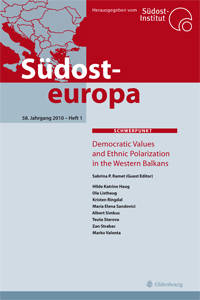The main purpose of this article is to examine whether the concepts of “class voting” and political cleavages used in studies of western democracies are of relevance in post-communist Albania. The analysis of voting behavior, based on a representative survey conducted in late 2003, resulted in only weak correlations between voting and socio-demographic variables such as gender, age, and education. A weak tendency for class voting was evident, but in the opposite direction to what is common in western democracies in that non-manual workers voted more frequently for the Socialist Party than did manual workers. The main political cleavage in Albania is the regional divide between the more-developed south, where the majority has preferred the Socialist Party, and the less-developed north, where the majority has voted for the Democratic Party.
Ringdal, Kristen & Teuta Starova (2010) Social Dimensions of Party Choice in Albania, Südosteuropa 58 (1): 109–127.







